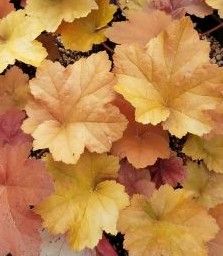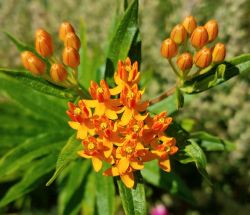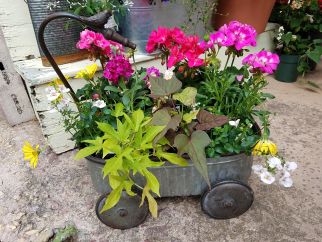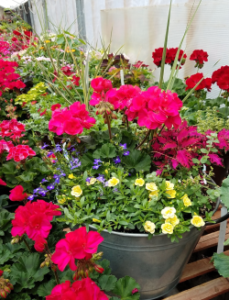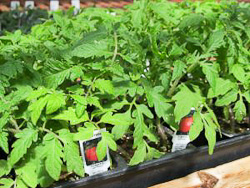Sunset Greenhouse: 1023 Sunset Road * 80909 (719) 634-6232
PLANTING FOR THE GOOD GUYS!!
In a world laden with synthetic and even organic pesticides, wouldn’t it be nice to return to a harmony with the way things are supposed to be, where the good bugs eat the bad bugs? If we provide the right plants, they will come…
Alyssum: flowers attract hoverflies whose larva devour aphids; draws bees to pollinate early blooming fruit trees
Borage: deters tomato hornworms and cabbage worms; one of the best bee and wasp attracting plants.
Carrots: blooms attract hoverflies and predatory wasps
Calendula: attracts bees and hoverflies
Catnip/Catmint: deters flea beetles, aphids, Japanese beetles, squash bugs, ants and weevils.
Chamomile, German: host to hoverflies and wasps.
Centaurea: attracts bees, lacewings, hoverflies and parasitic wasps.
Chives: attract hoverflies, bees and parasitic mini-wasps; keep aphids away from tomatoes,
Chervil: keeps aphids off lettuce
Cilantro: repels harmful insects such as aphids, spider mites and potato beetle. A tea from this can be used as a spray for spider mites
Cosmos: attracts lacewings, hoverflies and parasitic wasps
Dill: flower umbel attracts ladybugs, lacewings, hoverflies and parasitic mini-wasps but also the tomato horn worm so it would be wise to plant it somewhere away from your tomato plants.
Fennel: foliage and flowers attract hoverflies, ladybugs, tachninid flies, beneficial parasitoid wasps. It can retard the growth of some nearby plants.
Garlic: systemic in action as it is taken up by the plants through their pores and when garlic tea is used as a soil drench it is also taken up by the plant roots. It has value in offending codling moths, Japanese beetles, root maggots, snails, and carrot root fly
Golden Rod: one of the best; attracts assassin bugs, big-eyed bugs, ladybugs, lacewings, hoverflies, praying mantis and parasitic wasps.
Lavender: repels fleas and moths. Prolific flowering lavender nourishes many nectar feeding and beneficial insects. Lavenders can protect nearby plants from insects such as whitefly, and lavender planted under and near fruit trees can deter codling moth.
Marigold: has roots that exude a substance which spreads in their immediate vicinity killing harmful nematodes.
Mint: the menthol content in mints that acts as an insect repellant and tiny flowers attract Braconid and Icheumonid wasps, and Tachnid and Syrid flies; bees and other good guys love it; deters white cabbage moths, ants, rodents, flea beetles, fleas, aphids. Earthworms are quite attracted to mint plantings, and it may deter ground squirrels and mice from tunneling in the area.
Morning Glory: attracts syrphid flies and ladybugs
Nasturtium: deter aphids, squash bugs, and striped pumpkin beetles.
Oregano: plant near broccoli, cabbage and cauliflower to repel cabbage butterfly and near cucumbers to repel cucumber beetle.
Parsley: flowers attract parasitic wasps and hoverflies.
Thyme: deters cabbage worms.
Yarrow: attracts predatory wasps and ladybugs; good accelerant to the compost pile.
Plants that attract Lacewings:
Achillea filipendulina Fern-leaf yarrow
Anethum graveolens Dill
Angelica gigas Angelica
Anthemis tinctoria Golden marguerite
Atriplex canescens Four-wing saltbush
Callirhoe involucrata Purple poppy mallow
Carum Carvi CarawayCoriandrum sativum Coriander
Cosmos bipinnatus Cosmos white sensation
Daucus Carota Queen Anne’s lace
Foeniculum vulgare Fennel
Helianthus maximilianii Prairie sunflower
Tanacetum vulgare Tansy
Taraxacum officinale Dandelion
Plants that attract Hoverflies:
Achillea filipendulina Fern-leaf yarrow
Achillea millefolium Common yarrow
Ajuga reptans Carpet bugleweed
Alyssum saxatilis Basket of Gold
Anethum graveolens Dill
Anthemis tinctoria Golden marguerite
Asclepias tuberosa Butterfly weed
Atriplex canescens Four-wing saltbush
Coriandrum sativum Coriander
Daucus Carota Queen Anne’s lace
Fagopyrum esculentum Buckwheat
Foeniculum vulgare Fennel
Helianthus maximilianii Prairie sunflower
Penstemon strictus Rocky Mt. penstemon
Potentilla recta ‘warrenii’ Sulfur cinquefoil
Potentilla villosa Alpine cinquefoil
Tagetes tenuifolia Marigold – lemon gem
Tanacetum vulgare Tansy
Taraxacum officinale Dandelion
Veronica spicata Spike speedwell
Vicia villosa Hairy vetch
Plants that attract Ladybugs:
Achillea filipendulina Fern-leaf yarrow
Achillea millefolium Common yarrow
Ajuga reptans Carpet bugleweed
Alyssum saxatilis Basket of Gold
Anethum graveolens Dill
Anthemis tinctoria Golden marguerite
Asclepias tuberosa Butterfly weed
Atriplex canescens Four-wing saltbush
Coriandrum sativum Coriander
Daucus Carota Queen Anne’s lace
Fagopyrum esculentum Buckwheat
Foeniculum vulgare Fennel
Helianthus maximilianii Prairie sunflower
Penstemon strictus Rocky Mt. penstemon
Potentilla recta ‘warrenii’ Sulfur cinquefoil
Potentilla villosa Alpine cinquefoil
Tagetes tenuifolia Marigold – lemon gem
Tanacetum vulgare Tansy
Taraxacum officinale Dandelion
Veronica spicata Spike speedwell
Vicia villosa Hairy vetch
Plants that attract Parasitic Mini-Wasps:
Achillea filipendulina Fern-leaf yarrow
Achillea millefolium Common yarrow
Allium tanguticum Lavender globe lily
Anethum graveolens Dill
Anthemis tinctoria Golden marguerite
Astrantia major Masterwort
Callirhoe involucrata Purple poppy mallow
Carum Carvi Caraway
Coriandrum sativum Coriander
Cosmos bipinnatus Cosmos white sensation
Daucus Carota Queen Anne’s lace
Foeniculum vulgare Fennel
Limonium latifolium Statice
Linaria vulgaris Butter and eggs
Lobelia erinus Edging lobelia
Lobularia maritima Sweet alyssum – white
Melissa officinalis Lemon balm
Mentha pulegium Pennyroyal
Petroselinum crispum Parsley
Potentilla recta ‘warrenii’ Sulfur cinquefoil
Potentilla villosa Alpine cinquefoil
Sedum kamtschaticum Orange stonecrop
Tagetes tenuifolia Marigold – lemon gem
Tanacetum vulgare Tansy
Thymus serpylum coccineus Crimson thyme
Zinnia elegans Zinnia – liliput
Plants that attract Minute Pirate Bugs, Damsel Bugs and Big Eyed Bugs:
Caraway Carum Carvi
Cosmos – white sensation Cosmos bipinnatus
Fennel Foeniculum vulgare
Alfalfa Medicago sativa
Spearmint Mentha spicata
Peter Pan goldenrod Solidago virgaurea
Marigold – lemon gem Tagetes tenuifolia
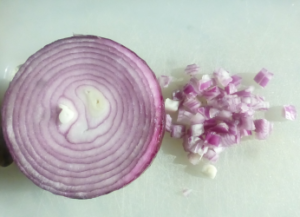 Any of the alliums can be sown in the garden March/April and can be planted provided the plants are hardened off. They like a loose, moist (not wet) well-drained soil.
Any of the alliums can be sown in the garden March/April and can be planted provided the plants are hardened off. They like a loose, moist (not wet) well-drained soil.
